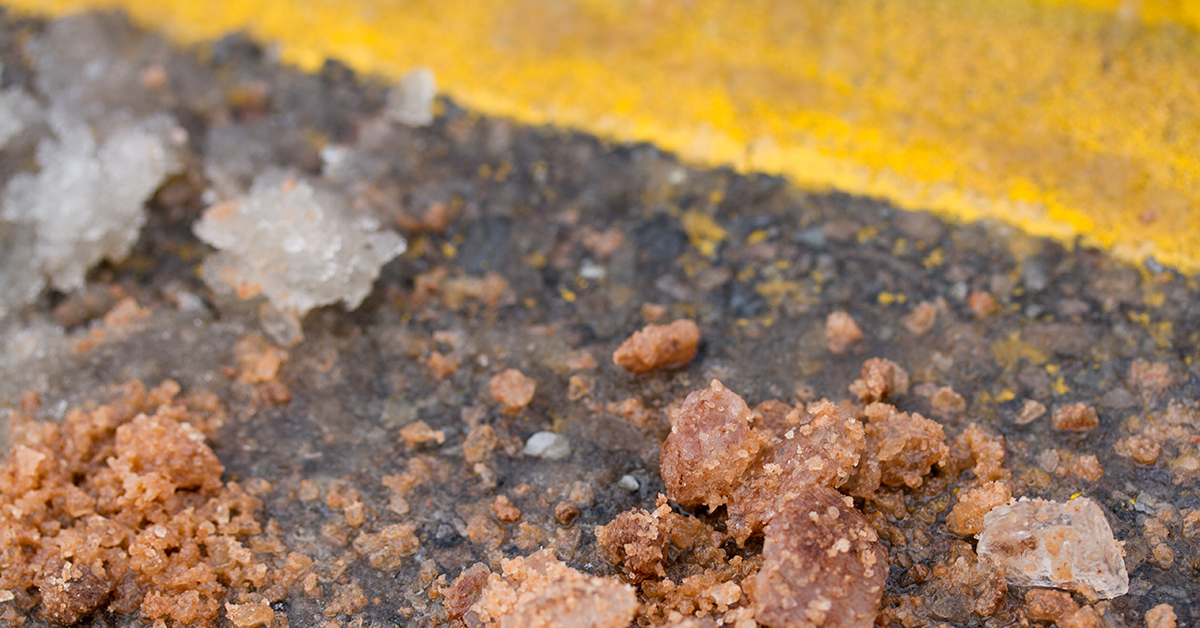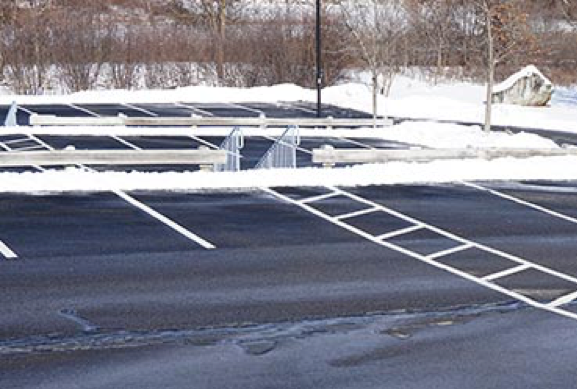Commercial snow removal customers often ask why not use sand as the preferred deicer. It comes down to several different factors as to why this may not be the best answer. Below is a mailbag format with many of the most common questions asked about using sand and an alternative that provides many of the benefits without all the negatives.

Sand is cheap. Why not just use Sand all the time?
Using sand all the time to help save, but unfortunately, sand isn’t effective at melting ice, it is bad for the environment, it’s really hard to clean up in spring, and often times sand is mixed with salt to provide some melting capabilities. Back when everyone used sand all the time, the sand would accumulate in holding ponds and rivers. This had tremendous negative effects on the water levels and the water content. The sand also accumulates in parking lots and roads which requires a street sweeper or otherwise involved work to clean up once the snow has melted. The primary drawback with sand is sweeping it up between storms to prevent little piles from building up on your walkways and steps. One way to reduce the need for aggregates is the use of Ice Slicer which creates natural traction that other granular deicers cannot provide. Sand usage is then minimized or even eliminated in many instances, which decreases sediment-loading problems in sensitive areas.
When to use sand?
Sanding of most areas is limited to during heavy snowfall because the sand is quickly covered and then removed as additional plowing occurs. Sand is used in areas in which the snow was compacted hard. Sand can be effective on ice to provide traction; however in very cold temperatures, it does not stick well. When applying sand, special attention is given to sections of the network posing specific safety concerns. These include, but are not limited to, areas such as: school and hospital zones, police and fire stations, bridges and overpasses, turn lanes, acceleration or deceleration lanes, approaches to intersections that are stop sign or signal controlled, curves, steep grades, heavy traffic areas, areas of ice accumulation, speed bumps, and areas with other known problem is strictly an abrasive material. Unlike salt, sand doesn’t melt snow and ice; it sits on top. With only a few cars passing over a sanded area, the sand is pushed below the surface of the hard pack or ice. Once the sand is below the surface, it no long provides traction.
Sand doesn’t melt Ice?
Sand is strictly an abrasive material. Unlike salt, sand does not melt snow and ice; it sits on top, providing a gritty surface to improve traction and help prevent slips and falls. The primary function of sand is that, when applied liberally, it gives great traction on slick roads. In cold temperatures, sand can clump up and freezing but if the sand is mixed with Ice Slicer or SOS then sand mixture does not clump up and continues to give traction.
What to do around landscaping?
Traction The use of Sand for snow control can have detrimental effects unless cleaned up. And while you may not be able to keep your property safe for pedestrian traffic without using chemical deicers, you can take steps to minimize their impact on your landscape. Avoid planting sensitive plants where there is likely to be deicer exposure: near roadways, sidewalks, etc. Annuals might be your best bet in these areas. Use alternatives to rock salt such as Ice Slicer (OMRI Listed), magnesium chloride, calcium chloride, and acetate compounds. While technically salts, they are generally far less harmful to plants and the environment. Follow directions on the product label to avoid overuse of product. Remove as much snow and ice as possible with a shovel before applying salts. This will keep your need for deicers to a minimum, and help them work more effectively.
What are others saying about sand?
Sand, which once was one of Seattle’s main weapons against icy streets, is now more likely to harm aquatic life than the salt and the city refuses to use out of concern for its environmental effects. Also in Washington State, Environmental concerns about salt haven’t garnered a lot of attention in Tacoma, but community-relations manager Rob McNair-Huff said sand is actually of larger concern. “It both clogs up the drainage systems and can be damaging as far as the habitats of macroinvertebrates [insects] and salmon.” Many of you in the Denver area that were here in past winters, are probably all too familiar with Denver’s “Brown Cloud”, which was determined to be partially caused by the application of sand and abrasives during storm events, and has been identified by the Regional Air Quality Council (RAQC) as a major contributor to the Denver metropolitan area’s particulate pollution. Fewer particulates in Ice Slicer versus a mix white salt and sand or sand alone. This equates to less air quality issues in PM-10 and PM-2.5 areas. The use of aggregates (like sand) can create many air quality concerns. Clean Up costs with sand are often prohibitive; Connecticut DOT switched to a complete chemical winter maintenance program and are saving $2.5 million per year in clean-up costs. In the Denver area costs near $175/Ton have been seen for cleaning up sand.

Which is better for the environment, sand or salt?
Road salt makes the rivers and lakes much more full of alkalinity, which has bad effects on the plant and animal life near them. Salt also corrodes steel and other metal structures. As discussed earlier, sand filters into rivers and lakes to make them fill up more. Also, sand is often mixed with salt so all the problems with salt apply to sand as well. So neither of them is great for the environment. Protecting our streams is one of the primary reasons that Ice Slicer is chosen, as it is less harmful to aquatic life than white salt because it does not contribute as much to biological oxygen demand. Ice Slicer is an eco-friendly solution that naturally adds grit to the road without having to use sand, which can contribute to sedimentation loading in streams, which can be harmful to aquatic life. Another point about Ice Slicer – Due to the physical composition of Ice Slicer, less material is needed to provide a safe surface and its less corrosive than white (rock) salt.
What are the conclusions?
Overall, both have their purpose, but because of heavy clean up requirements, it is often cheaper to use an alternative chemical deicer like Ice Slicer, magnesium chloride or others ensuring the use levels are correct to minimize ill effects. Denver area Engineering/Public Works Departments are required under legal mandates, which are regulated by the RAQC, to comply with certain application rates. Limiting the application rates reduces the quantity of particulates in the air and the amount of chemicals and sand deposited in wetlands and waterways. Because of these air quality impacts, the use of sand or abrasives in snow control has been virtually eliminated in the Denver metro area. Finally when it comes to safety a concern with sand is when used on pavement, sand can act like marbles and cause slip and falls.
Want to Learn More?
Whether you want sand or salt, we are here to help. If you would like to talk to a representative about optimizing your deicing or anti-icing program, feel free to contact EnviroTech at 1-800-369-3878.
For more information about EnviroTech Services’ please visit our website at www.envirotechservices.com or call 800-881-5848.


